Abstract
Renewable energies play an important role as a solution to the challenge of satisfying the growing global energy demand without jeopardizing the achievements in the fight against climate change. Given this panorama, different countries, including Spain, have developed policies to promote renewable energies. One of the technologies that benefit from these policies is photovoltaics. In Spain, the number of grid-connected photovoltaic installations has increased significantly in recent years. It is interesting to analyze the panorama of these facilities and identify the trends in their design criteria. In this line, in this work, the projects of 70 grid-connected photovoltaic installations distributed across Spain were analyzed. For that purpose, benchmarking techniques were applied, facilitating the systematization of information, the intercomparison of plants and the identification of trends and efficient solutions. A set of characteristic indicators of each installation was defined, and a statistical analysis of them was developed. Likewise, a tool was developed that allows the designers of this type of photovoltaic plant to compare the design parameters chosen for their installations with those of the surrounding area. Therefore, this work provides knowledge about the current panorama of photovoltaic implementation applicable to its future advance.
1. Introduction
Considerable population growth and high levels of industrialization have led to an increase in energy demand, which, in turn, has led to worldwide concern for the reduction of the level of greenhouse gas emissions. The solution to this problem requires a firm decision to reduce the use of fossil fuels by all countries through a firm commitment to power generation from renewable sources. However, the reduction of these emissions is still well below the levels necessary to achieve a reduction in the negative impact that the environment is continually undergoing.
Being aware of the climate emergency, the UN held the United Nations Climate Change Conference (COP26) in Glasgow in November 2021. In it, representatives of nearly 200 countries met with the clear objective of accelerating the climate action established in the Paris agreement [1] that aims to reduce emissions in 2030 by 45%, with respect to the reference year 2010, and sets as a clear goal a level of zero net emissions in 2050 [2].
In regard to this, the latest World Energy Statistical Review [3] has determined that primary energy consumption during 2020 decreased for the first time since 2009 globally by 4.5%. The largest falls were registered in North America (8%) and the European Union (7.8%), and a growth of 9.7% in renewable energies was observed. Although these figures are encouraging, it is still an effect caused by the crisis generated at a global level by the effect of COVID-19, which led to volatility and interruption of the world energy markets and, consequently, a decrease in energy demand.
This situation is corroborated by the International Energy Agency (IEA) in its report on the impact of the effect of COVID-19 on global energy demand in 2020 [4]. The report states that in that year, the global level of CO2 emissions decreased by around 8% or the equivalent of 2.6 Gt. Likewise, it is stated that this has been the largest year-on-year reduction in history (even higher than that caused by the financial crisis) and in which the demand for all fuels, except renewables, experienced its largest contractions in decades.
While the effects of the pandemic are still being felt globally and many economies are in the process of recovering, Russia’s invasion of Ukraine on 24 February 2022, has generated serious concern around the world, not only because of the humanitarian disaster and the loss of human lives that any war implies, but also due to the scarcity of materials and difficulties in transportation, as well as the negative effect of this conflict on the energy sector. The alignment of almost all countries with the Ukraine and, consequently, the condemnation of the excessive act by Russia have led to the imposition of sanctions. Among them, the EU has approved a package of measures prohibiting the import of coal and fuels solid fossils from Russia to member countries from next 20 August [5]. Consequently, this measure implies gradually eliminating the energy dependence of these member countries on Russia. This measure is in line with the Versailles Declaration [6], which establishes as one of the priority measures the promotion of renewable energies and the production of their key components, simplifying authorization procedures to accelerate projects in the field of energy. It is important to point out that it is estimated that the energy dependence on fossil fuels (gas, oil and coal) of the European Union (EU) with respect to Russia ranged between 57% and 60% of gross energy consumption in the last 5 years [7]. Therefore, although the national production of renewable energy sources has increased significantly within the EU countries, the scenario that is outlined in the face of the firm decision taken is not simple and implies drastic measures.
Accordingly, the implementation of the REPowerEU plan [8] establishes as one of the fundamental pillars the promotion of an integrated energy system based largely on production from renewable sources. Specifically, for this year (2022), the deployment of 15 TWh in photovoltaic production is proposed, which would help save an additional 2.5 bcm of gas in the EU.
Therefore, photovoltaic (PV) technology forms an important part of the EU’s energy strategy. It is important to point out that this technology is undergoing major advances thanks to technological developments and research. In this regard, the need to optimize operating conditions has led to the use of various techniques in the field of grid-connected plants. Thus, for example, techniques based on IoT are being incorporated to help solving problems related to the maintenance and management of the facilities, while adding advantages such as being non-invasive and low-cost techniques [9,10,11,12]. Likewise, in the case of plants with solar tracking, new tracking strategies are being designed and incorporated to optimize the capture of solar irradiance and, therefore, to increase electricity production levels [13,14]. In support of this line of improvement, Gómez-Uceda et al. [15] developed an omnidirectional sensor to identify the orientation of the solar collectors for which solar irradiance is maximum, while avoiding inter-shading between PV panels. Another option for improving the efficiency of grid-connected PV plants is to study the possible technical and economic locations of the plants on the basis of weather-related issues. In this line of work, the work of Ahmed et al. [16], with respect to various climatic zones in Pakistan, is noteworthy. The use of exergoeconomic and exergoenvironmental maps, which provide a very useful tool for the sizing and location of photovoltaic plants, is also noteworthy. Thus, Rahnama et al. [17] present a study based on this technique on different areas in Iran.
These technological improvements, together with the need to design a more sustainable energy scenario, are favoring the growth of PV. In fact, in 2019, the installed PV power experienced an increase of 134 GW and, according to forecasts, in 2030, the increase will be 370 GW, which represents 3.9% of the gross production of electricity within the EU and would imply a job creation of around 200,000 jobs [18].
Furthermore, EurObserv’ER, an entity of the European Union that acts as a barometer of renewable energies, in its latest photovoltaic annual report [19], highlights that PV capacity worldwide took off in the year 2020 despite the anomalous situation caused by COVID-19. At the same time, the IEA PVPS TRENDS 21 report [20] identifies a global increase of 145.2 GWp, which represents an increase of 31.2% compared to the previous year (2019). Such growth raises the PV production capacity to 773.2 GWp, with China leading this growth with an increase of 59%, followed by the USA with 48.1%. Regarding the behavior of the EU, according to the referenced report, it increased its net capacity by 18.22 Gwp in 2020, registering a growth of 12.9% compared to 2019.
In Spain, the National Integrated Energy and Climate Plan 2021–2030 (NIECP) sets a roadmap for the next decade with the clear objective of reducing the country’s energy dependence, as well as reaching zero emission levels by 2050 [21]. To achieve these goals, different initiatives have been developed, such as the Draft Royal Decree regulating the Renewable Energy Economic Regime for Electric Power Production facilities [22]. In this plan, the installation of 5000 MW/year of power provided by renewable sources is contemplated for the period 2021–2030.
In Spain, electricity generation in 2020 was around 250 TWh, with the renewables sector accounting for 45.5% of such production and increasing its share by 6.6% compared to the previous year (38.9%). In this scenario, wind power is the main source of production with 49.4% of renewable energy, followed by hydro, with 28.1%, and photovoltaic in third place, with 13.7%, with the latter being the one with the greatest growth (68.5%) [23]. Likewise, the report on the progress of the Spanish electricity system indicates that, in 2021, the installed electrical power of solar PV increased by almost 30%, reaching 15,048 MW [2].
Within the EU, Spain led the growth in PV production in 2019. This situation was driven, to a great extent, by the end to the taxation of self-consumption energy, the introduction of compensation mechanisms for excess production and the definition of the conditions for the creation of energy communities [24]. However, in 2020, Spain relinquished this leadership to Germany, which regained its position as the largest PV energy market within the EU due to its prosperous self-consumption market, helped by a relatively high price of electricity for households and an attractive purchase premium mechanism for medium- and large-scale commercial systems (40–750 kW) [19].
Nevertheless, Spain is considered one of the countries with the greatest potential for PV growth due to its geographical location and the high number of hours of sunshine it receives. This situation has been supported in recent years by the state of maturity that the PV sector has acquired due to market regulation [25], through the regulatory framework of the Renewable Energy Economic Regime (REER) and the provision of a fixed price for the energy generated [26], as well as a complete reform of the regulatory framework for access and connection with the approval of RD 1183/2020 [27]. All this has led to the PV capacity existing at the end of 2018 being tripled in 2021 [28].
The foregoing proposes a favorable scenario for the PV sector, not only as a step toward a strategy of commitment to renewable energies, but also because it is associated with higher job creation rates per MW than other energy sources [29]. Therefore, the need arises to carry out a study on the reality of PV production facilities in Spain. In this line, benchmarking techniques can be very useful to characterize the installations that are currently being projected in our country.
Benchmarking emerges as a continuous improvement strategy in the business environment [30]. To do so, it is based on the definition and comparative analysis of a set of indicators that systematize and simplify the information on the most relevant processes in business activity. In this way, the continuous analysis of these indicators within the company itself and outside it in other companies with comparable activity that evidence good practices in the area of interest leads to the identification of possible improvement actions to be developed in the search for continuous improvement [31,32].
Although, as has been said, this practice was born in the business world, it has now spread to different areas, with the appropriate and necessary modifications for its adaptation to each sector. Examples of this are public benchmarking [33], which seeks to optimize the management of public and/or government administrations and evaluate the success of the policies they develop, or city benchmarking, which, according to Luque-Martínez and Muñoz-Leiva [34], is defined as a systematic method to improve the actions of a city from the identification of the most effective practices and capacities of other cities.
Likewise, in recent times, benchmarking has begun to be implemented in the energy sector. In this regard, various works apply benchmarking to building design as a methodology to improve their energy efficiency [35,36,37,38,39,40,41]. Benchmarking is also used in industry to compare (process by process) the performance of a company with other more efficient corporations from an energy point of view [33].
Within this energy sector, as mentioned above, PV is experiencing a very significant boom, and the number of grid-connected PV installations is increasing considerably. In this context, the need arises to optimize these installations by identifying the most efficient configurations from a technical and economic point of view. To do this, it is necessary to analyze the different characteristic parameters of these PV plants in terms of their design (area used, number of collectors, number of inverters, power, production, etc.) and cost (total investment and broken down by items). In this regard, the amount of information available and susceptible to study is enormous, so it is necessary to organize and systematize it to interpret it and for its analysis to lead to relevant conclusions with real applicability. In this line, benchmarking techniques can be very useful to identify the optimal design configurations for efficient PV plants. Likewise, benchmarking applied to the characterization of grid-connected PV plants can help decision-makers to comparatively evaluate the characteristics of their PV plants (already implemented or in the design and development phase) with respect to those of their environment and identify and transfer good practices that allow them to improve the operation of the PV plant for which they are responsible. Therefore, in order to apply benchmarking to the efficient design of grid-connected PV plants, it is necessary to select a set of indicators that systematize the information on PV plants, simplify their analysis and facilitate their intercomparison [42]. These indicators may be characteristic and measurable variables of the PV plant that are treated independently or relationships between two or more of these variables. In any case, the selection of these indicators is crucial for the success of the benchmarking since they must allow us to identify the differences between some plants and others, as well as determine the most efficient of them [42,43].
In this line, this paper presents a selection of indicators applicable to grid-connected PV plants. Once these indicators were defined, they were applied to a wide range of grid-connected PV installations designed and authorized throughout Spain. Thus, thanks to these indicators, it has been possible to characterize these PV plants. In that way, the further usefulness of these indicators is, through benchmarking techniques, to extract meaningful and comparative information about the PV facilities. From this analysis, it will be possible to describe the most common practices in the design of these facilities, as well as to identify the most efficient typologies and designs of PV installations. Likewise, a free tool is provided that will allow the person in charge of any grid-connected PV plant to compare the characteristics of his/her plant with respect to the whole and thus identify if it is convenient to make decisions that help them improve its efficiency.
2. Materials and Methods
To characterize the current trends in the design of grid-connected PV plants, this study analyzed the execution projects for the installation of 70 grid-connected PV plants distributed throughout the Spanish territory (Figure 1) and projected in Spain between the years 2021 and 2022. In accordance with Spanish legislation, before being definitively authorized, these execution projects must remain on public display for a minimum period of 30 days. In this way, the execution projects that are analyzed in this work were obtained by downloading each of the projects individually during the said period of public exposure. Specifically, the download was carried out during the months of March and April 2022 from the public display portals that each of the autonomous communities has in terms of energy or from the Spanish government website, through its delegations in each of the regions [44,45,46,47,48,49,50]. Although we were not able to analyze certain autonomous communities due to the lack of information available online regarding PV installations, we achieved a wide spatial distribution of plants for analysis.
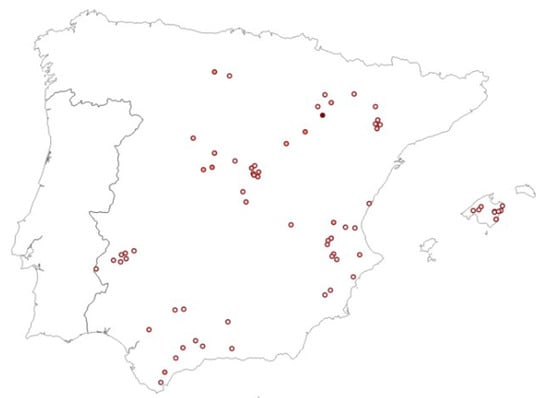
Figure 1.
Geographical location of the grid-connected PV installations whose projects were analyzed in the study.
It is important to point out that, in accordance with the regulations, this public-exposure phase must always be prior to the execution phase, so the data included in the documents are always projected data, not measured. Moreover, since these are projects, they can be considered documents that reflect the agreements achieved between the developer and the contractor of the PV plant, so they contain detailed data on all costs (PV modules, inverters, etc.).
Likewise, it is important to point out that the database obtained from this process of downloading execution projects includes a significant variety of typologies and that it can be considered representative of the panorama of grid-connected PV installations in Spain. Specifically, the extension of these plants varies from 0.40 to 561.83 Ha, with the most common extension range being [50, 100 Ha) in which 32.86% of the plants are included, followed by the intervals [0, 10 Ha) and [100, 200 Ha), with 22.86% and 20.00% of the plants, respectively. Compared to these more frequent extensions, only 5.71% of the considered plants exceed 200 Ha of extension. Regarding the installed peak power, it is observed that the distribution varies between 0.83 and 292.00 MWp. In this way, while only 6 plants of the 70 studied (8.57%) exceed 100 MWp of installed power, the rest are more or less homogeneously distributed in the range up to 100 MWp, with 38.57% of the cases with powers belonging to the interval [10, 50 MWp), 28.57% of the cases in the interval [0–10 MWp) and 24.29% of the cases in the interval [50, 100 MWp). Finally, regarding the planned budget for the execution of the plant, the most economical plant implies a cost of EUR 362,727.00 compared to EUR 88,372,135.00 for the most expensive plant. In this case, most of the budgets (26 installations, 37.14%) exceed EUR 20 million. Compared to them, 21 plants (30.00%) have budgets of less than EUR 5 million. In the intermediate range of budgets, 12.86% of the plants imply global budgets belonging to the interval [15, EUR 20 million), 11.43% of the plants to the interval [10, EUR 15 million) and 8.57% of the plants to the interval [5, EUR 10 million). It is verified, therefore, that the sample includes a wide variety of typologies of grid-connected PV plants.
To homogenize the results, the same set of characteristic data was extracted from all the projects considered. Table 1 shows the considered variables classified into 6 large blocks: general characteristics of the installation, characteristics of the photovoltaic modules, characteristics of the inverters, type of monitoring, characteristics of the transformation center and economic characteristics.

Table 1.
Variables analyzed for each of the execution projects considered.
Based on these variables, in this first study, a set of indicators was defined that allows us to characterize the behavior of the grid-connected PV plants under study, systematizing the information included in the database and facilitating the intercomparison of PV plants, in accordance with benchmarking techniques [42]. Table 2 shows the list of these indicators, their symbols and definition.

Table 2.
Indicators defined in the benchmarking study applied to grid-connected PV plants in Spain.
In accordance with the abovementioned, the work database includes for each of the 70 facilities studied the set of variables and indicators that are collected in Table 1 and Table 2, respectively. In this way, it is possible to systematize the information on the global vision of the panorama of grid-connected PV installations in Spain and its main design characteristics. Likewise, a comparison pattern is obtained that facilitates the intercomparison between installations and the identification of the most efficient configurations.
3. Results
Based on the information collected in the database with the 70 grid-connected PV installations studied, a statistical analysis of the main indicators was carried out. Table 3 shows the maximum, minimum, mean, median, standard deviation and variation coefficient values of each of the calculated indicators.

Table 3.
Characteristic statistical values of each of the calculated indicators.
Likewise, the histogram of each of the indicators was obtained, in which each of the classes considered for the different indicators is represented by its intermediate value. This section discusses the main results derived from this statistical analysis that helps describe trends in the design of grid-connected PV plants in Spain.
Figure 2 shows the histogram of the (%) index, which represents the percentage of oversizing of the peak power (MWp) of the PV plant with respect to its nominal power (MW). It is observed that, compared to only 1.43% of the installations in which the nominal power is greater than the peak power, in 98.57% of the installations considered, the peak power of the installation exceeds its nominal power. Specifically, this increase in peak power with respect to the nominal power is between 10% and 30% in 70% of cases. Higher increases (between 30% and 40%) are only registered in 5.71% of the installations.
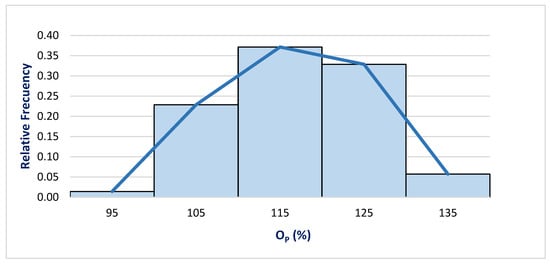
Figure 2.
Histogram of the index .
Regarding the index (kWp/Ha), which represents the density of land use or the quotient between the installed peak power (kWp) and the area dedicated to the PV plant (Ha), its histogram (Figure 3) shows that the most representative value of this index (with 51.42% of the PV plants) is between 400 and 600 kWp/Ha, followed by the 600–800 kWp/Ha class with the 15.71% of the cases. Likewise, it is observed that, in general terms and with the exception of the 1200–1400 kWp/Ha class, the relative frequencies of the classes considered decrease as the index values move away from these more frequent classes. In this way, the minimum relative frequency is recorded for the classes in which the extreme values of the index are included, that is, for the classes 0–200 kWp/Ha and 1400–1600 kWp/Ha, with 1.43% facilities in both cases.
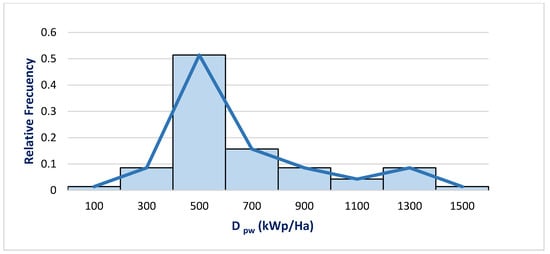
Figure 3.
Histogram of the index .
Figure 4 shows the histogram of the indicator (kWh·year−1/kWp), which is defined as the quotient between the annual production of the installation (kWh·year−1) and the installed peak power (kWp). The analysis shows that this rate ranges from 1400 to 2500 kWh·year−1/kWp. Within this interval, 57.14% of the installations present values between 1800 and 2100 kWh·year−1/kWp, with the most frequent value being between 2000 and 2100 kWh·year−1/kWp present in 24.28% of the total cases analyzed. Likewise, it is observed that the relative frequency decreases significantly from 2100 kWh·year−1/kWp.
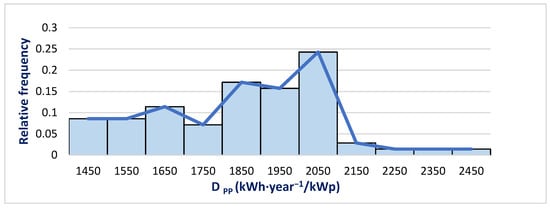
Figure 4.
Histogram of the index .
Next, the trend of the indicator . (MWh·year−1/Ha) is analyzed, which represents the energy density or relationship between the level of energy production of the installation (MWh·year−1) and the area of land that the entire PV installation occupies (Ha). The corresponding histogram (Figure 5) shows that, in more than half of the installations considered (51.42%), this energy density varies between 900 and 1300 MWh·year−1/Ha. The distribution of index values for the rest of the cases is homogeneous, with similar relative frequencies, and close to 5% in all cases, except for the classes corresponding to the extreme values of the index (300–500 MWh·year−1/Ha and 2100–2300 MWh·year−1/Ha) that only occur in 2 of the 70 installations in each case (2.86%).
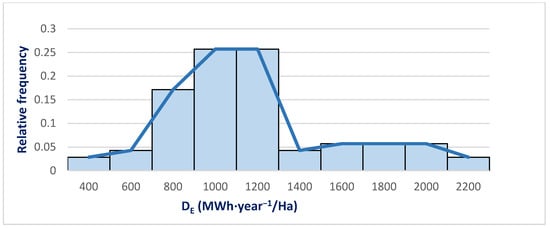
Figure 5.
Histogram of the index .
Once the indicators related to the density of energy production and installed power were analyzed, the indicators related to the economic investment necessary for the design, development and implementation of the PV plants under study in this work were analyzed. In this way, firstly, the indicator . (kEUR/Ha) represents the investment density and is defined as the quotient between the global budget (kEUR) and the area of land occupied by the PV plant (Ha). The histogram of . (Figure 6) shows that there is great variability in terms of investment density, although 75.69% of the installations have required an economic investment of between 100 and 400 kEUR/Ha. Only in the case of one facility (1.42%) is the investment less than 100 kEUR/Ha compared to 12.85% of facilities for which investment levels reach the highest values of the indicator (900 and 1400 kEUR/Ha).
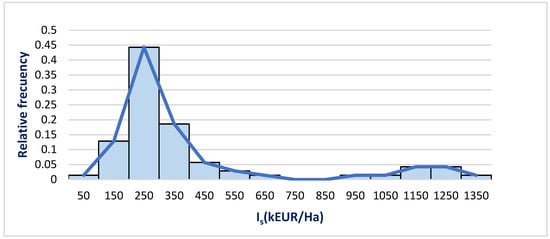
Figure 6.
Histogram of the index .
Another parameter closely related to the return on investment will be the . (EUR/W) indicator since it represents the ratio between the global budget and the nominal installed power. Figure 7 shows that the most frequent values of this indicator vary between 0.50 and 0.70 EUR/W (54.28% of installations), followed by an investment between 0.40 and 0.50 EUR/W (12.85% of installations). The number of installations that require an investment greater than 0.70 EUR/W adds up to 25.71% of the cases; those greater than 1 EUR/W are 10.00% of the installations studied.
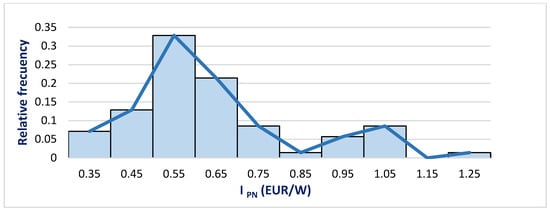
Figure 7.
Histogram of the index .
Similarly, the indicator . (EUR/W) is defined as the ratio between the global budget of the PV plant (EUR) and the installed peak power (Wp). Given that, as stated above, when defining the installation oversizing index, , the peak power is higher than the nominal power in most installations, and it is observed that the values of the . indicator (Figure 8) are slightly lower than those of the indicator. In fact, the values of . do not exceed 1 EUR/Wp in any case. The most frequent values of . are between 0.40 and 0.60 EUR/Wp for 64.28% of the installations, followed by an investment of between 0.30 and 0.40EUR/W for 11.42% of the installations.
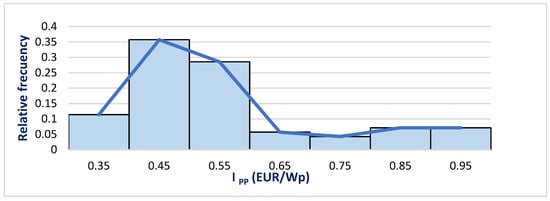
Figure 8.
Histogram of the index .
Once the economic and energetic parameters of the PV plants have been studied, several indicators related to the design parameters of the different components of the PV plants will then be analyzed (PV modules, inverters, …).
First, starting with the characterization of the PV modules used in the plants, Figure 9 shows the histogram of the (Wp) indicator, which is defined as the peak power (Wp) of the modules under Standard Test Conditions (STCs). It is observed that the variability of the indicator is wide, with the most frequent value being between 450 and 500 Wp, characteristic of the modules used in 25.71% of the installations, followed closely by panels with . powers between 500 and 550 Wp present in another 21.42% of the facilities. Likewise, it is observed that the relative frequencies of use of panels with . below 450 Wp are in all cases less than 10%, totaling only 12.86% of the facilities studied. On the contrary, the relative frequencies for the use of panels with a greater than 550 Wp are greater than 10% with 12.86% of cases using panels with a between 550 and 600 Wp, 17.14% of cases between 600 and 650 Wp and 10% of the cases using panels with between 600 and 650 Wp, with this being the maximum interval for the indicator.
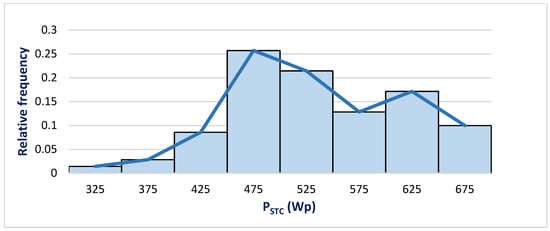
Figure 9.
Histogram of the index .
Similarly, the indicator (Wp) is related to the characterization of the modules used in the design of PV plants. Specifically, it represents the peak power of the modules under NOCT conditions. Figure 10 shows that the variability of this indicator is much lower than that of , varying between 250 and 550 Wp, and it can also be seen that the distribution is more homogeneous since, except for the values between 500 and 550 Wp, where a single case is registered, for the remaining classes, the relative frequency is between 19.70% (350–400 Wp) and 27.27% (450–500 Wp).

Figure 10.
Histogram of the index .
Regarding the efficiency defined by the manufacturers for the PV modules used, (%), it can be seen (Figure 11) that the efficiency range is between 18% and 24%, with the interval between 20% and 22% being the most frequent (90% of the cases studied).
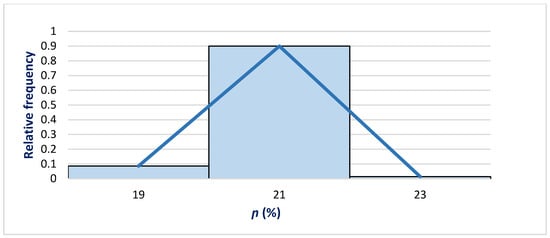
Figure 11.
Histogram of the index .
For the characterization of the inverters, the (kVA) index is defined, which represents the nominal power installed in the inverters of each PV plant. The results obtained for this indicator show great variability (Figure 12), which is because the indicator depends on the design strategies, establishing an inversely proportional relationship between the number of inverters and their installed power. The results show that the nominal power range of the inverters is between 100 and 4800 kVA. However, it is verified that the most frequent classes for are 0–500 kVA, 1500–1750 kVA and 3500–3750 kVA, with 41.66%, 13.33% and 11.66% of the cases, respectively. For the rest of the indicator values, the relative frequency does not exceed 10% in any case.
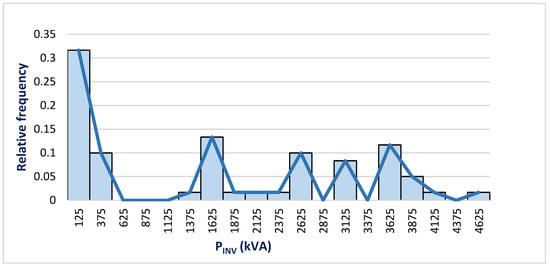
Figure 12.
Histogram of the index .
Continuing with the characterization of the inverters, the indicator represents the number of strings per inverter. Once again, its histogram shows a high dispersion (Figure 13) attributed to the dependence of this indicator on the strategy used to define the number of inverters in the installation. Despite this, it is found that the most common configuration has less than 20 strings per inverter, with a relative frequency of 27.14%. This relative frequency exceeds by more than double the relative frequency of any of the remaining classes considered for this indicator.
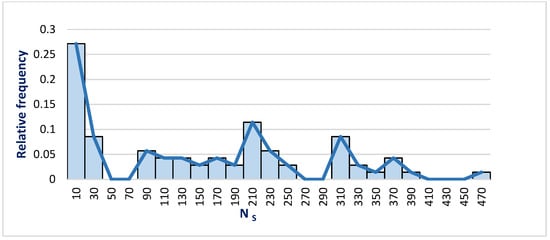
Figure 13.
Histogram of the index .
The following two indicators are related to the percentage of the budget dedicated to each of the most important components of the installation: the modules and the inverters. In the first place, the behavior of the percentage ratio between the budget dedicated to modules (kEUR) and the total installation (kEUR), (%), that is, the cost of the modules with respect to the total investment, is studied. Figure 14 shows that the weight of the cost of the modules of a grid-connected PV installation ranges between 20% and 75%; however, 75.71% of the installations present a percentage cost of the modules between 35% and 55% of total investment.

Figure 14.
Histogram of the index .
Secondly, the percentage ratio of the cost of the power station (defined as the sum of the cost of the transformation center and the inverters) with respect to the total cost of the installation (both in kEUR) is analyzed, . (%). The corresponding histogram (Figure 15) shows that, in all cases, the cost of the power station is less than 45% of the total budget of the PV plant. However, in more than half of the cases analyzed (52.85%), the cost of the power station represents between 5% and 10% of the total budget, and in 28.57% of the cases, between 10% and 15%.
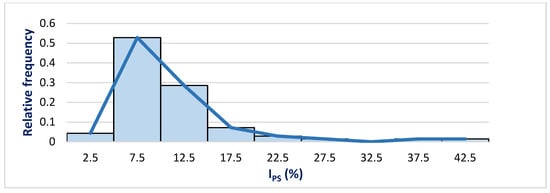
Figure 15.
Histogram of the index .
Finally, Figure 16 represents the histogram of the Ground Cover Ratio, . (%), defined as the percentage ratio between the surface of the land dedicated to PV modules and the total surface dedicated to the PV plant. It is important to point out that, due to the lack of data in some projects, this indicator was calculated for only 66 of the 70 installations analyzed (94.29%). Once again, this indicator shows high variability, with values ranging between 15% and 85%. However, within this range, it is verified that, in 53.33% of the cases, the varies between 30% and 45%. Compared to this interval of greater relative frequency, only 5.01% of these 66 installations present a . of less than 30%, and the remaining 29.45% of the installations present a that varies between 45% and 85%.
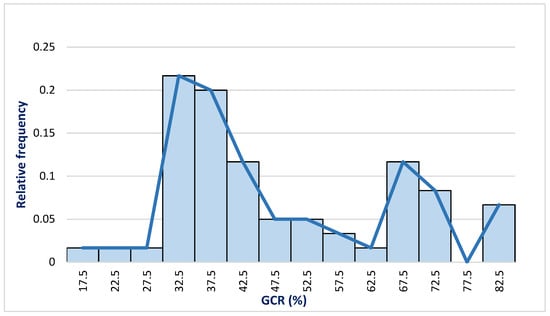
Figure 16.
Histogram of the index .
The previously presented indicators allow us to initiate a systematic study of comparison and classification of facilities, from which a deeper knowledge of the database could be retrieved. Thus, for example, by graphically comparing the energy density indicator, (MWh·year−1/Ha), against the ratio between the global budget (kEUR) and the land area (Ha), . (kEUR/Ha), the graph shown in Figure 17 is obtained. Specifically, the graph shows the points with . and . It can be seen that, for a given value of , there is a high dispersion of expected values of energy productivity. This will mean that, for a given plant, P (represented in Figure 17 by the red dot), the projects that are above it in its vertical should be considered as projects with higher performance, being from these projects from which P will be able to extract information to improve. Likewise, it can be concluded that the points in the upper envelope of the point cloud represent a subset of optimal projects or reference facilities from which the rest can learn the practices/techniques that will allow them to improve.
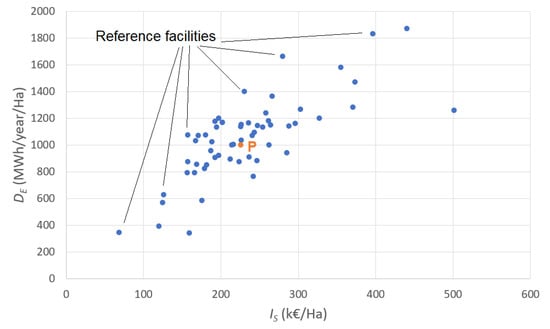
Figure 17.
Graphical representation of versus .
Moreover, as an example, from a technical design point of view, the graph in Figure 18 shows (MWh·year−1/Ha) versus (kWp/Ha). A similar analysis to the previous one can be performed here, as well as studying the changes in the trend, as the increases due to the interference effect between collectors as their surface density increases.

Figure 18.
Graphical representation of versus .
Finally, as Supplementary Materials to this first paper, a tool is freely provided to the reader so that the user can compare the trends of the grid-connected PV plants in Spain with any other installation, whether it is a plant already built or in the design phase. Specifically, the tool determines the indicators for the plant to be compared and automatically checks their location within the corresponding frequency diagram. By way of example, Figure 19 shows the diagram obtained by a user with . As can be seen, the class in which the user’s indicator is placed is highlighted in a different color. Thus, this application facilitates the intercomparison between different grid-connected PV plants and helps to identify possible improvements in their efficiency.
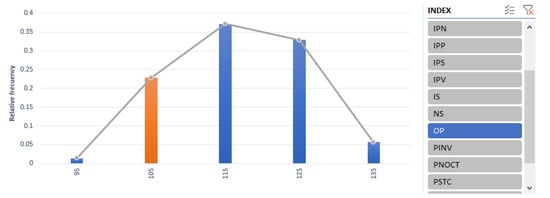
Figure 19.
Example of Excel application output provided as additional information.
4. Conclusions
The need to develop policies that promote renewable energy as a solution to climate change is giving rise to a growth in grid-connected PV plants. Given this situation, it is convenient to characterize the trends in the criteria and strategies that have been used in the design of these facilities. In this line, in the present work, the main indicators that allow us to characterize the grid-connected PV installations were selected and described. Once these indicators were defined, they were applied and calculated for a sample of 70 grid-connected PV plants projected in Spain between the years 2021 and 2022. To do so, the information available in their corresponding projects accessible on the online boards of public exhibition of the different autonomous communities were used, as well as those of the Government of Spain. Once the projects were analyzed and the previously defined indicators were calculated, a database was obtained with the information of the 70 grid-connected PV plants. The application of benchmarking techniques to this database has made it possible to systematize the information, facilitating the intercomparison of the characteristics of different grid-connected PV plants and the identification of the most frequent practices in terms of their design. Specifically, for each of the defined indicators, a statistical analysis was carried out, obtaining the main statistical parameters (minimum, maximum, median, mean, standard deviation and variation coefficient), as well as the corresponding histogram of relative frequencies. Therefore, benchmarking techniques will allow designers and promoters of project plants to estimate their indicators and be able to compare them with those obtained in the sample described in this work. Future plant designers are recommended to represent each of their indices on the histograms provided (Figure 2, Figure 3, Figure 4, Figure 5, Figure 6, Figure 7, Figure 8, Figure 9, Figure 10, Figure 11, Figure 12, Figure 13, Figure 14, Figure 15 and Figure 16), with the aim of qualitatively evaluating their indicators as high or low in relation to current trends in the design of grid-connected PV plants in Spain. In this regard, the justification of the positioning obtained by each indicator of a facility implies a deepening exercise in the knowledge of the proposed solution. To carry out this exercise, a toll is provided as an annex to this paper, where the calculation of the indicators and their graphical representation of the values obtained within the sample histogram are automated.
Likewise, the database presented will allow for the development of future research based on cluster analysis, which will facilitate the identification of the typologies of real installations based on their indicators. Furthermore, the application of DEA (Data Envelopment Analysis) techniques, which consider each PV installation as a productive unit, will allow for the global efficiency of each installation to be established in the use of resources in a broad sense (radiation, surface and capital). To illustrate the results of this line of work, two examples of comparative analysis of indicators were presented (Figure 17 and Figure 18). Within each cluster, the said efficiency is determined, as well as the possibility of indicating to each productive unit with efficiency less than one which are the reference productive units. Thus, non-efficient productive units can identify those units that are efficient and from which they could extract information to improve.
Therefore, the compilation carried out on the updated information of the set of grid-connected PV installations and its reflection and systematization in indicators is of great interest. The expansion and continuous updating of this database and the comparative analysis of the information it collects, as well as the definition and analysis of new indicators, will allow the sector to develop and search for the most efficient designs.
Supplementary Materials
The following supporting information can be downloaded at: https://www.mdpi.com/article/10.3390/technologies10060131/s1, Toos S1: Spreadsheet for the comparative analysis of photovoltaic plant design indicators.
Author Contributions
Conceptualization, R.L.-L.; methodology, F.J.G.-U. and R.L.-L.; software, R.L.-L.; validation, M.V.-M. and J.C.R.-F.; formal analysis, F.J.G.-U. and J.C.R.-F.; investigation, F.J.G.-U. and L.M.F.-A.; resources, J.C.R.-F. and L.M.F.-A.; data curation, J.C.R.-F. and L.M.F.-A.; writing—original draft preparation, F.J.G.-U.; writing—review and editing, M.V.-M.; visualization, M.V.-M.; supervision, R.L.-L.; project administration, M.V.-M.; funding acquisition, L.M.F.-A. All authors have read and agreed to the published version of the manuscript.
Funding
This research received no external funding.
Institutional Review Board Statement
Not applicable.
Informed Consent Statement
Not applicable.
Data Availability Statement
A tool, based on the results of this study, is provided to make it easier for designers of new plants and those responsible for plants already in operation to compare the plants with those in their environment, helping them in their decision-making and the search for possible improvements in the efficiency of the installation.
Conflicts of Interest
The authors declare no conflict of interest.
References
- Horowitz, C.A. Paris Agreement. Int. Leg. Mater. 2016, 55, 740–755. [Google Scholar] [CrossRef]
- UNFCCC COP 26. Glasgow Climate Pact; United Nations: Glasgow, UK, 2021; pp. 1–8. Available online: https://unfccc.int/sites/default/files/resource/cma2021_10_add1_adv.pdf (accessed on 16 October 2022).
- British Petroleum. Statistical Review of World Energy globally consistent data on world energy markets and authoritative publications in the field of energy. BP Energy Outlook 2021, 70, 8–20. [Google Scholar]
- International Energy Agency. Global Energy Review 2020; IEA: Paris, France, 2020. [Google Scholar] [CrossRef]
- European Union. Council Regulation (EU) 2022/576 of 8 April 2022 Amending Regulation (EU) No 833/2014 Concerning Restrictive Measures in View of Russia’s Actions Destabilising the Situation in Ukraine; European Union: Luxembourg, 2022; Volume 2003, Available online: https://eur-lex.europa.eu/legal-content/EN/TXT/PDF/?uri=CELEX:32022R0576 (accessed on 16 October 2022).
- European Council. Versailles Declaration. 2022. Available online: https://www.consilium.europa.eu/media/54773/20220311-versailles-declaration-en.pdf (accessed on 16 October 2022).
- European Comission. REPowerEU Plan. 2022. Available online: https://eur-lex.europa.eu/legal-content/EN/TXT/HTML/?uri=CELEX:52022DC0230&from=EN (accessed on 16 October 2022).
- European Commission Annex—REPowerEU. Joint European Action for more affordable, secure and sustainable energy EN. Eur. Comm. 2022, 2022, 3. [Google Scholar]
- Dupont, I.M.; Carvalho, P.C.M.; Jucá, S.C.S.; Neto, J.S.P. Novel methodology for detecting non-ideal operating conditions for grid-connected photovoltaic plants using Internet of Things architecture. Energy Convers. Manag. 2019, 200, 112078. [Google Scholar] [CrossRef]
- Rus-Casas, C.; Hontoria, L.; Fernández-Carrasco, J.I.; Jiménez-Castillo, G.; Muñoz-Rodríguez, F. Development of a utility model for the measurement of global radiation in photovoltaic applications in the internet of things (IoT). Electronics 2019, 8, 304. [Google Scholar] [CrossRef]
- Paredes-Parra, J.M.; García-Sánchez, A.J.; Mateo-Aroca, A.; Molina-García, Á. An alternative internet-of-things solution based on LOra for PV power plants: Data monitoring and management. Energies 2019, 12, 881. [Google Scholar] [CrossRef]
- Pereira, R.I.S.; Dupont, I.M.; Carvalho, P.C.M.; Jucá, S.C.S. IoT embedded linux system based on Raspberry Pi applied to real-time cloud monitoring of a decentralized photovoltaic plant. Meas. J. Int. Meas. Confed. 2018, 114, 286–297. [Google Scholar] [CrossRef]
- Fernández-Ahumada, L.M.; Ramírez-Faz, J.; López-Luque, R.; Varo-Martínez, M.; Moreno-García, I.M.; Casares de la Torre, F. A novel backtracking approach for two-axis solar PV tracking plants. Renew. Energy 2020, 145, 1214–1221. [Google Scholar] [CrossRef]
- Fernández-Ahumada, L.M.; Ramírez-Faz, J.; López-Luque, R.; Varo-Martínez, M.; Moreno-García, I.M.; Casares de la Torre, F. Influence of the design variables of photovoltaic plants with two-axis solar tracking on the optimization of the tracking and backtracking trajectory. Sol. Energy 2020, 208, 89–100. [Google Scholar] [CrossRef]
- Gómez-Uceda, F.J.; Ramirez-Faz, J.; Varo-Martinez, M.; Fernández-Ahumada, L.M. New Omnidirectional Sensor Based on Open-Source Software and Hardware for Tracking and Backtracking of Dual-Axis Solar Trackers in Photovoltaic Plants. Sensors 2021, 21, 726. [Google Scholar] [CrossRef] [PubMed]
- Ahmed, N.; Naveed Khan, A.; Ahmed, N.; Aslam, A.; Imran, K.; Sajid, M.B.; Waqas, A. Techno-economic potential assessment of mega scale grid-connected PV power plant in five climate zones of Pakistan. Energy Convers. Manag. 2021, 237, 114097. [Google Scholar] [CrossRef]
- Rahnama, E.; Aghbashlo, M.; Tabatabaei, M.; Khanali, M.; Rosen, M.A. Spatio-temporal solar exergoeconomic and exergoenvironmental maps for photovoltaic systems. Energy Convers. Manag. 2019, 195, 701–711. [Google Scholar] [CrossRef]
- European Union. Progress on Competitiveness of Clean Energy Technologies; European Union: Brussels, Belgium, 2020; Available online: https://energy.ec.europa.eu/progress-competitiveness-clean-energy-technologies_en (accessed on 16 October 2022).
- EurObserv’ER Consortium. État des Énergies Renouvelables en Europe , 2021 ed.; 20th EurObserv’ER Report; urObserv’ER: Paris, France, 2022; Available online: https://www.eurobserv-er.org/etat-des-energies-renouvelables-en-europe-2021/ (accessed on 16 October 2022).
- Masson, G.; Kaizuka, I. Trends in Photovoltaic Applications 2021; Report IEA-PVPS T1-41; IEA: Paris, France, 2021; ISBN 9783906042916. Available online: https://iea-pvps.org/wp-content/uploads/2022/01/IEA-PVPS-Trends-report-2021-4.pdf (accessed on 16 October 2022).
- Ministry for Ecological Transition and the Demographic Change of the Spanish Government. Estrategia de Descarbonizacion a Largo Plazo 2050. 2020. Available online: https://energia.gob.es/_layouts/15/HttpHandlerParticipacionPublicaAnexos.ashx?k=16822 (accessed on 16 October 2022).
- Ministry for Ecological Transition and the Demographic Change of the Spanish Government. Real Decreto 960/2020, de 3 de Noviembre, por el que se Regula el Régimen Económico de Energías Renovables para Instalaciones de Producción de Energía Eléctrica; Ministry for Ecological Transition and the Demographic Change of the Spanish Government: Madrid, Spain, 2021; pp. 26798–26800. Available online: https://www.boe.es/eli/es/rd/2020/11/03/960 (accessed on 16 October 2022).
- Red Electrica de España. El Sistema Eléctrico Español 2020. Red Eléctrica de España (REE). 2021. Available online: https://www.ree.es/sites/default/files/publication/2022/05/downloadable/inf_sis_elec_ree_2020_0.pdf (accessed on 16 October 2022).
- Ministry for Ecological Transition and the Demographic Change of the Spanish Government. Real Decreto 244/2019, de 5 de Abril, Por el Que se Regulan Las Condiciones Administrativas, Técnicas y Económicas del Autoconsumo de Energía Eléctrica; Ministry for Ecological Transition and the Demographic Change of the Spanish Government: Madrid, Spain, 2019; Volume 6, pp. 35674–35719. Available online: https://www.boe.es/eli/es/rd/2019/04/05/244 (accessed on 16 October 2022).
- Head of State of the Spanish Government. Real Decreto-Ley 23/2020, de 23 de Junio, por el que se Aprueban Medidas en Materia de Energía y en Otros Ámbitos para la Reactivación Económica; Head of State of the Spanish Government: Madrid, Spain, 2020; pp. 43879–43927. Available online: https://www.boe.es/eli/es/rdl/2020/06/23/23/con (accessed on 16 October 2022).
- Ministry for Ecological Transition and the Demographic Change of the Spanish Government. Real Decreto 960/2020, de 3 de Noviembre, por el que se Regula el Régimen Económico de Energías Renovables para Instalaciones de Producción de Energía Eléctrica; Ministry for Ecological Transition and the Demographic Change of the Spanish Government: Madrid, Spain, 2020; Volume 13249, pp. 101239–101266. Available online: https://www.boe.es/eli/es/rd/2020/11/03/960/con (accessed on 16 October 2022).
- Ministry for Ecological Transition and the Demographic Change of the Spanish Government. Real Decreto 1183/2020, de 29 de Diciembre, de Acceso y Conexión a las Redes de Transporte y Distribución de Energía Eléctrica; Ministry for Ecological Transition and the Demographic Change of the Spanish Government: Madrid, Spain, 2020; Volume 2014, pp. 18987–19106. Available online: https://www.boe.es/eli/es/rd/2020/12/29/1183/con (accessed on 16 October 2022).
- Hemetsberger, W.; Couet, C.; Schmela, M. EU Market Outlook for Solar Power 2021–2025; Solar Power Europe: Brussels, Belgium, 2021; ISBN 9789464444292. Available online: https://www.solarpowereurope.org/insights/market-outlooks/market-outlook#downloadForm (accessed on 16 October 2022).
- Blyth, W.; Gross, R.; Speirs, J.; Sorrell, S.; Nicholls, J.; Dorgan, A.; Hughes, N. Low carbon jobs: The evidence for net job creation from policy support for energy efficiency and renewable energy. In Proceedings of the BIEE 10th Academic Conference, London, UK, 17–18 September 2014; Volume 31. [Google Scholar]
- Camp, R.C. Benchmarking: The search for industry best practices that lead to superior performance. Qual. Prog. 1989, 22, 66–68. [Google Scholar] [CrossRef]
- Spendolini, M.J. The benchmarking process. Compens. Benefits Rev. 1992, 24, 21–29. [Google Scholar] [CrossRef]
- Curtis, D. Benchmarking: A tool for facilitating organizational learning? Public Adm. Dev. 2002, 22, 109–122. [Google Scholar] [CrossRef]
- Saygin, D.; Worrell, E.; Patel, M.K.; Gielen, D.J. Benchmarking the energy use of energy-intensive industries in industrialized and in developing countries. Energy 2011, 36, 6661–6673. [Google Scholar] [CrossRef]
- Luque-Marínez, T.; Muñoz-Leiva, F. City benchmarking: A methodological proposal referring specifically to Granada. Cities 2005, 22, 411–423. [Google Scholar] [CrossRef]
- Chung, W. Review of building energy-use performance benchmarking methodologies. Appl. Energy 2011, 88, 1470–1479. [Google Scholar] [CrossRef]
- Chung, W.; Hui, Y.V.; Lam, Y.M. Benchmarking the energy efficiency of commercial buildings. Appl. Energy 2006, 83, 1–14. [Google Scholar] [CrossRef]
- Al-Homoud, M.S. Computer-aided building energy analysis techniques. Build. Environ. 2001, 36, 421–433. [Google Scholar] [CrossRef]
- Li, Z.; Han, Y.; Xu, P. Methods for benchmarking building energy consumption against its past or intended performance: An overview. Appl. Energy 2014, 124, 325–334. [Google Scholar] [CrossRef]
- Salleh, M.N.M.; Kandar, M.Z.; Sakip, S.R.M. Benchmarking for Energy Efficiency on School Buildings Design: A Review. Procedia Soc. Behav. Sci. 2016, 222, 211–218. [Google Scholar] [CrossRef][Green Version]
- Borgstein, E.H.; Lamberts, R. Developing energy consumption benchmarks for buildings: Bank branches in Brazil. Energy Build. 2014, 82, 82–91. [Google Scholar] [CrossRef]
- Geraldi, M.S.; Bavaresco, M.; Gnecco, V.M.; Azevedo, L.D.; de Ghisi, E.; Fossati, M. Análise estatística da intensidade do uso de energia de edificações escolares no Brasil: Proposição de benchmarking simplificado. Rev. Sítio Novo 2022, 7, 21–34. [Google Scholar] [CrossRef]
- Rodríguez-Díaz, J.A.; Camacho-Poyato, E.; López-Luque, R.; Pérez-Urrestarazu, L. Benchmarking and multivariate data analysis techniques for improving the efficiency of irrigation districts: An application in spain. Agric. Syst. 2008, 96, 250–259. [Google Scholar] [CrossRef]
- Rodríguez Díaz, J.A.; Camacho Poyato, E.; López Luque, R.; Pérez Urrestarazu, L. Los indicadores de gestión y las técnicas de benchmarking aplicados a la mejora de las comunidades de regantes. Ing. Agua 2005, 12, 63–76. [Google Scholar] [CrossRef]
- Delegation of the Government of Castilla La Mancha Public Information Procedures Notice Board of the Government of Castilla La Mancha. Available online: https://www.mptfp.gob.es/portal/delegaciones_gobierno/delegaciones/castillalamancha/proyectos-ci/informacion-publica.html%0D%0A (accessed on 20 March 2022).
- Regional Government of Extremadura Public Information of the Department of Ecological Transition and Sustainability of the Regional Government of Extremadura. Available online: http://industriaextremadura.juntaex.es/kamino/index.php/area-de-energia/generacion-de-energia/informacion-publica%0D%0A (accessed on 14 February 2022).
- Government of Andalucía Public Information Procedures Notice Board of the Government of Andalucía. Available online: https://www.juntadeandalucia.es/organismos/haciendayfinanciacioneuropea/servicios/participacion/todos-documentos.html%0D%0A (accessed on 23 February 2022).
- Government of Aragon Public Information Procedures Notice Board of the Government of Aragon. Available online: https://www.aragon.es/buscador/-/search/type/20501/portal/0/filter/0-465154-466682/page/0/q/fotovoltaico%0A%0A (accessed on 27 March 2022).
- Autonomous Community of Madrid Public Information Board for Industry, Energy and Mines of the Autonomous Community of Madrid. Available online: https://www.comunidad.madrid/inversion/industria/informacion-publica-materia-industria-energia-minas (accessed on 27 April 2022).
- Delegation of Goverment of Castilla Leon Public Information Notice Board on electricity Installations of the Delegation of Goverment of Cstilla Leon. Available online: https://www.mptfp.gob.es/portal/delegaciones_gobierno/delegaciones/castillaleon/proyectos-ci/Informaci-n-P-blica/INSTALACIONES-EL-CTRICAS.html (accessed on 2 March 2022).
- Delegation of Government of Region of Murcia Public Information Procedures Notice Board of the Delegation of Government of Region of Murcia. Available online: https://www.mptfp.gob.es/portal/delegaciones_gobierno/delegaciones/comunidad_valenciana/proyectos-ci/Procedimientos-de-informacion-publica.html (accessed on 15 February 2022).
Publisher’s Note: MDPI stays neutral with regard to jurisdictional claims in published maps and institutional affiliations. |
© 2022 by the authors. Licensee MDPI, Basel, Switzerland. This article is an open access article distributed under the terms and conditions of the Creative Commons Attribution (CC BY) license (https://creativecommons.org/licenses/by/4.0/).